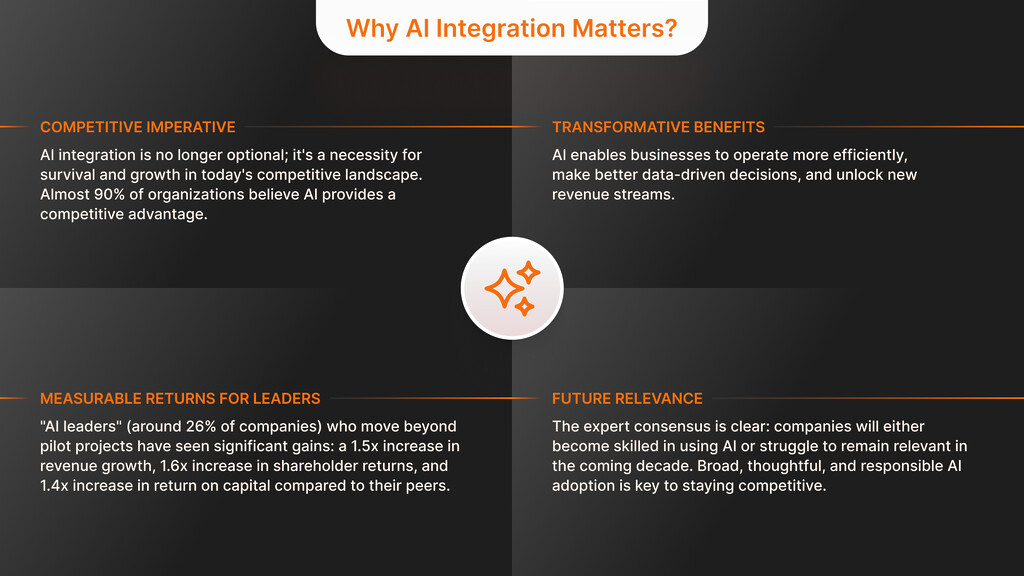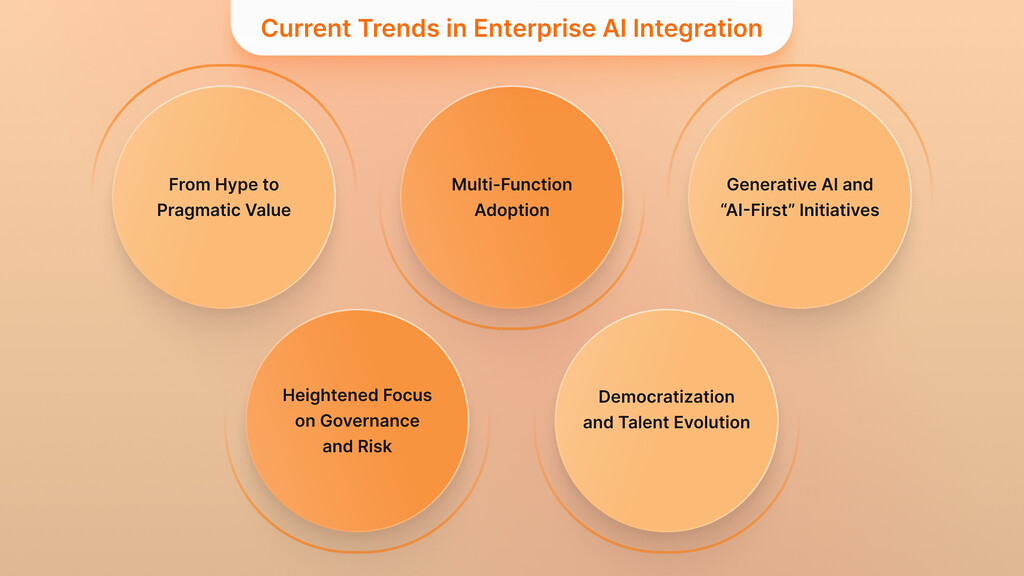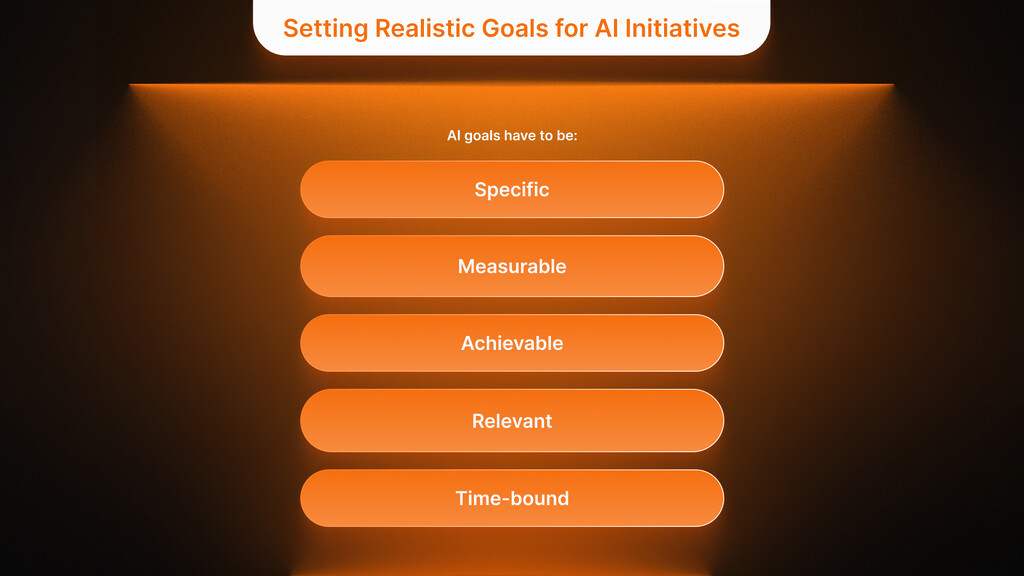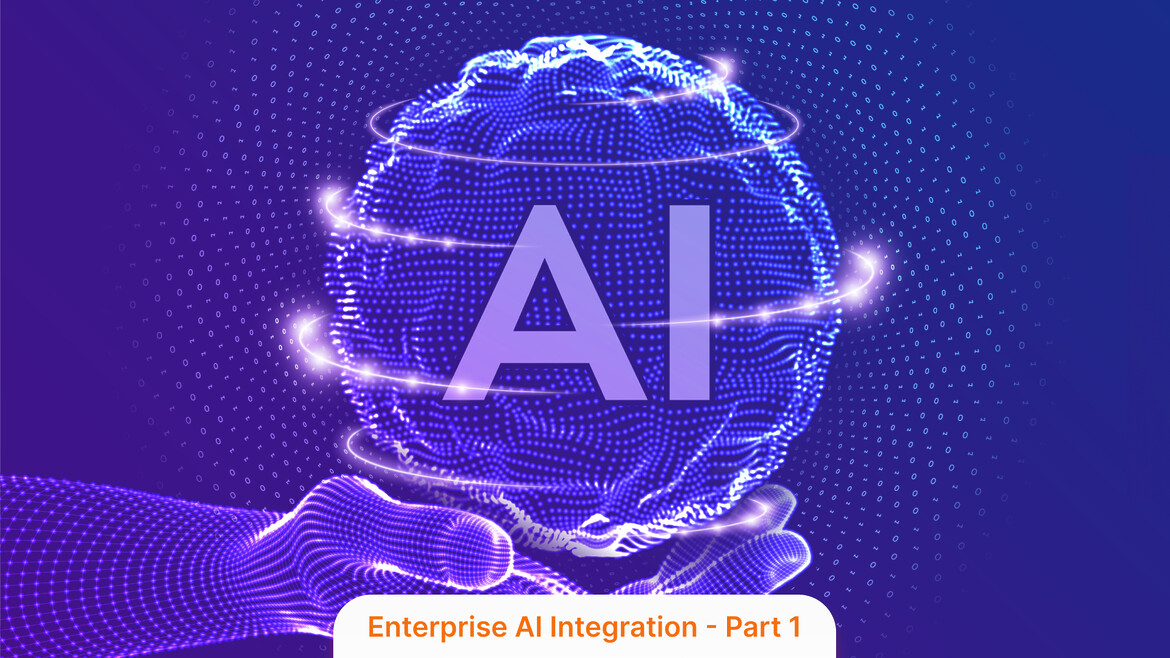Artificial Intelligence has shifted the experimentation stage to the implementation stage in the contemporary business environment. The AI is no longer a futuristic idea that can already be observed in the context of web development, backend systems, and business operations.
However, the successful integration of AI requires more than just implementing a model; it necessitates in-depth knowledge of your organization’s technical infrastructure, data quality, governance practices, and team preparedness. Lacking such clarity, even the most well-financed AI efforts tend to fail to scale or provide any significant ROI.
Experience Expert IT Consultancy
Transformative Strategies for Your Technology Needs
Discover IT ConsultingThe first part of the Enterprise AI Integration Playbook focuses on the Introduction and Assessment Stage, which is the most critical phase that determines long-term success. In the following chapters, we are going to examine modern trends in enterprise AI, take a step-by-step tour of practical readiness frameworks, and identify some of the most crucial metrics that can help you assess whether your business is ready to take the next step.
If you are running a digital program in a mid-sized organization or rolling out AI in a large organization, this guide can help you reveal strengths, identify gaps, and develop a roadmap for responsible and high-impact AI adoption.
Why AI Integration Matters?

In the hyper-competitive world of today, artificial intelligence integration on an enterprise level is no longer an option but rather a survival and growth necessity. Almost 90% of organizations in the world feel that AI will provide them with a competitive advantage over competitors. The transformation through integrating AI will enable businesses to operate more efficiently, make better decisions based on data, and open new innovative revenue streams.
In the case of progressive businesses, effective AI adoption is already bringing tremendous returns in terms of efficiency, innovation, and market share. On the contrary, those companies that are reluctant or have a haphazard implementation of AI face the risk of being left behind by tech-savvy competitors.
Experience the Power of Digital Transformation
Transformative Solutions Designed for Your Digital Growth
Explore Digital TransformationHard Numbers: The Edge Enjoyed by AI Leaders
In addition to anecdotal optimism, studies are measuring the difference in value between AI leaders and laggards. A global survey conducted by Boston Consulting Group showed that the group they call the AI leaders (the approximate 26% of the companies capable of going beyond pilot projects) have realized a 1.5x increase in revenue growth, a 1.6x increase in shareholder returns, and a 1.4x increase in returns to capital than their peers.
Such executives view AI as revolutionary and concentrate on fundamental business operations (where 62% of the value of AI is located) as opposed to back-office functions alone. They bet heavily on talent and ramp up the most promising AI solutions, anticipating achieving 60% more AI-driven revenue growth and nearly 50% more cost savings by 2027 compared to others. These numbers explain the importance of AI integration: when done correctly, they provide an enormous competitive edge and a measurable ROI.
The Pilot‑Purgatory Problem
Nevertheless, this value has not been achieved by most enterprises. Even after years of experimentation, 74% of companies have not demonstrated material value in using AI, and remain mired in “pilot purgatory” and unable to achieve AI scale throughout the business. The few in the elite (approximately 4%) possess state-of-the-art, fully scaled AI, which provides immense value. Most of them are yet to convert AI investments into bottom-line results.
The existence of this playbook is due to the fact that effective enterprise AI implementation is not easy; it requires more than technology. It needs strategic alignment, readiness of the organizations, and enduring change management to escape some pitfalls.
In a nutshell, the integration of AI is not only a matter because it is a trend, but also due to the fact that it is becoming part of the competitive strategy. When one of the experts summarized it, there will soon be only two types of companies: the ones that are dexterous in using AI and those that will truly struggle to remain relevant. The adoption of AI on a broader enterprise scale is the key to remaining relevant during the next decade, as long as it is done thoughtfully and responsibly.
Current Trends in Enterprise AI Integration

In 2025, enterprise AI reaches an inflection point. With a decade of slow and steady growth, the last two years have witnessed an explosion in the use of AI, particularly driven by advances in generative AI. The recent McKinsey global survey revealed that 72% companies have implemented AI in at least one area, a rise from 50% survey.
What is more impressive, 65% of organizations have started to use generative AI (including GPT-based solutions) regularly in at least one business unit, which is almost twice as many as 12 months ago. This massive expansion of gen AI implies that 2024 marked the time when companies switched to implementing AI on a large scale, instead of just being interested in it.
There are a few main trends that the integration of AI in enterprises currently follows:
From Hype to Pragmatic Value
The early hype of AI (particularly genAI) is being replaced by what can be called positive pragmatism. Companies are implementing at a more practical rate, with core value as opposed to hype. According to Deloitte, although the rate of technology changes is fast, the rate of organizational change is not that swift; it is companies themselves that determine the pace at which they can realize ROI, and that they are moving away from experimentation to scaling successful use cases in areas that matter to business success. Concisely, leaders want to see real business results, rather than cool demos, in AI projects.
Multi-Function Adoption
Businesses are using AI in more business components. The percentage of companies applying AI in two or more functions has increased by half and was below a third a year ago. The typical hotspots of genAI usage are marketing and sales, product development, and IT. These are the functions where AI can add a lot of value through personalizing customer experiences and speeding innovation.
At the same time, core business functions (such as manufacturing, logistics, and R&D) are becoming more AI-powered, with research showing that more than 60% of the value potential of AI lies in core business processes (as opposed to 38% in support functions). The tendency indicates the increased incorporation of AI into the very fabric of how enterprises operate, and not as a one-off pilot project.
Custom Software Development for a Competitive Edge
Build Unique Software Solutions with Our Expertise
Explore Custom SoftwareGenerative AI and “AI-First” Initiatives
The emergence of huge language models has encouraged numerous businesses to adopt an AI-first approach. Generative AI has reached a point where it is considered mission–critical: 75% of executives believe that it will massively disrupt their industry. Firms are in a sprint to see how to use AI assistants, content generators, and autonomous agents.
As an example, agentic AI (AI systems capable of making autonomous decisions) is also increasing, and the future of AI is in charge not only of predictions but also of decisions and actions in the workflow. The drive to embrace genAI is perhaps curbed by the necessity to establish proper governance (see below); yet, it is obvious that the integration of AI into products and services has become a priority in most industries.
Heightened Focus on Governance and Risk
With the ubiquity of AI, companies are having to deal with new risks, such as biased algorithms, IP, and privacy risks. In mid-2024, regulation and risk management became the most significant barrier to the deployment of AI, surpassing talent shortages. Businesses are already working to reduce the risk of genAI, such as its inaccuracy, cybersecurity, and copyright concerns; almost half of businesses already have some adverse effects of AI.
It has led to an increase in the number of those who have introduced stricter AI management practices (ethics committees, model validation processes, etc.). In fact, the need to have an AI governance framework in place is becoming a prerequisite to AI readiness in enterprises. The new agreement: responsible AI is an ethical issue, but it is also a business necessity to avoid regulatory and reputational damage.
Democratization and Talent Evolution
The other trend is the democratization of AI development. Businesses are empowering more employees (not only data scientists) to create or use AI solutions with AutoML, no-code AI tools, and cloud AI services. Meanwhile, the requirements of a workforce in an AI-based company are changing. Several organizations are recruiting or reskilling for positions such as AI product managers, data translators, and AI ethicists.
Interestingly, McKinsey observes that a few AI-related hiring difficulties have abated a bit, yet data scientists keep on being sought after, with half of the companies affirming that they require more than they possess. It is also focused on reskilling the current personnel- an increasing proportion of organizations state reskilling employees to operate efficiently with AI. In short, business organizations are trying to nurture an AI-enabled workforce across ranks.
In other words, the integration of AI into enterprises is shifting to maturity. There is widespread use, but there is also a dose of reality concerning the organizational effort that is necessary. Organizations are more selective when it comes to selecting high-impact AI projects that align with their strategy and are more aware of managing the risks associated with AI. In the following parts of this playbook, we will look into how to determine readiness and establish a basis so as to take advantage of these trends.
The article AI Integration for Business: Practical Steps to Implement and Scale emphasizes that companies have a challenge of scaling because the data is fragmented, teams are under-trained, and there is a lack of governance.
Assessing AI Readiness: Tools and Frameworks
Organizations need to be frank about the readiness of AI before they jump into AI initiatives. Not all companies are equally ready to use AI, and the failure to recognize the gaps may be very expensive. A readiness assessment sheds light on the existence of the foundations that are required to be able to implement AI integration in terms of strategy, data, skills, and culture.
The Six Pillars of Enterprise AI Readiness
What is the term AI-ready? According to the Global AI Readiness Index developed by Cisco, this is divided into six important pillars that have to be in sync with each other: Strategy, Infrastructure, Data, Governance, Talent, and Culture. That is, the preparation for AI cannot be reduced to the question of possessing the correct technologies; it involves the alignment of the business (strategy and culture), healthy IT, and data foundation, adequate governance, and the people with the right skills and mindset. These are the main pillars of enterprise AI readiness as summarized below:
- Strategy: Defined AI strategy and linkage to business; executive vision and support of AI. Establish your investment in AI and what success will be.
- Infrastructure: Scalable technology infrastructure to develop, deploy and execute AI (cloud or on‑prem); MLOps pipelines to move models through prototype to production. Make sure that IT architecture can accept AI workloads.
- Data: Quality, AI runs on readily available data. Assess data availability, silos, quality and governance. Are there data pipelines and platforms to feed AI models? Fill in data labeling, integration and storage gaps. The article Intelligent Document Processing on AWS presents how scalable architectures of IDP are essential to process unstructured data in enterprise settings.
- Governance: Guidelines to have responsible development and use of AI. This involves ethics, bias, privacy, and risk management policies, and oversight mechanisms (e.g. an AI ethics committee) to audit AI use cases that have high impact.
- Talent: AI skilled and knowledgeable individuals throughout the organization. This ranges to technical professionals (data scientists, ML engineers) and domain workers who are trained to operate AI in their tasks. It also implies developing change management skills and leaders capable of running AI projects.
- Culture: Culture of innovation, data‑driven decisions, AI experimentation within an organization. AI‑ready culture implies that the employees are willing to learn new tools, and there is a psychological safety to experiment with AI (not fearing that AI will steal their jobs). Leadership tone creates a sense that AI is at the heart of the future and should be embraced.
Streamlining Your Path to Effective Product Discovery
Make Your Ideas a Reality in Four Weeks with Our Results-Driven TechBoost Program
See Product Discovery ServicesFormal Assessment Tools & Benchmarks
The honest evaluation of all these aspects enables the recognition of the gaps in readiness. As an illustration, imagine that a company finds its IT system to be in sufficient shape, yet its data is extremely siloed and of low quality, which is a sure sign of struggling with AI. Or that it is full of technical talent, but without an AI plan and executive sponsorship, projects are doomed to be headless. A comprehensive evaluation usually entails questionnaires, interviews, and benchmarks.
There are a number of formal tools that organizations employ, including the Cisco AI Readiness Assessment (an online tool that encompasses the six pillars above) or the Deloitte AI Readiness Framework. The tools are used to rank the maturity of a company in each asset and differentiate readiness levels (e.g., Cisco distinguishes Pacesetters vs Chasers vs Followers according to the scores). Cisco Global Survey reveals that 13% of organizations are “Fully Prepared” AI Pacesetters, and most are moderate or limited in terms of readiness. It implies that the majority of companies have a long way to go before incorporating AI into their operations on a large scale.
Beyond Technology: Ethics, Empathy & Change Management
More importantly, readiness is not only technical. “AI success is all about being ready – not only technically ready, but ethically and emotionally ready, and operationally ready, at the enterprise level”, one analyst observed. Most companies are in a race to launch AI pilots based on technologies and models; however, they neglect those more subtle aspects of ethics, empathy, and change management. The result? Pieced-together pilots and the presence of resistance when projects hit cultural or organizational dead ends.
Key Questions to Surface Intangible Gaps
Does the leadership share a vision of AI? Does it have a champion at a high level? What will AI do to the role of employees, and are they ready for it? Is there any governance principle that governs ethical use? These are questions that an AI readiness assessment should raise sooner rather than later, not after a crisis but prior to a large-scale implementation.
Maturity Models to Position and Plan
In the assessment phase, a few companies develop an AI Maturity Model to plot their current position and where they should be. For example, the AI Readiness Model by TDWI or the AI Maturity framework by Gartner can serve as sources of industry benchmarks. This is aimed at objectively positioning the organization on a maturity scale (e.g., between an AI novice, which is an experimenting stage in silos, to an AI native, where AI is embedded and scaled).
Close Gaps Before You Scale
Where you are will determine the level of aggressiveness or conservative nature of your integration strategy. In case you find significant gaps (e.g., the lack of data governance or low AI literacy among employees), it might be a good idea to resolve those underlying problems first via specific efforts (e.g., implement a data governance program or run AI training programs) as a part of the integration plan.
Overall, do not forget about the readiness check. It will help you avoid wasting resources on an AI project and then seeing it stall because of an internal inability to keep up. With the help of the defined frameworks to evaluate the alignment of strategies, infrastructure, data, governance, talent, and culture, you lay the foundation of your AI integration process. That is also useful when it comes to realistic goals, which is a critical aspect to be discussed next.
Setting Realistic Goals for AI Initiatives

Among the initial actions in the AI integration playbook is to establish business-aligned goals that are realistic. One can be carried away by the hype of AI and the promise of delivering radical changes in results (“We will automate everything and 10x our productivity!”). However, the failure to realistically envisage the project is a sure way to kill an AI project. The usual case is that business leaders anticipate a new AI system will work some magic and solve all their problems overnight, which is most likely not the case. When initial outcomes are gradual (as is usual), the excessively boosted hopes are transformed into disappointment, and the project can be considered a failure at early stages.
Quantify Success Up Front
To prevent this boom and bust pattern, companies ought to base AI programs in quantifiable, transparent business-related goals and manage expectations of incremental gains. Even before constructing a model, one should ask: What are we trying to solve, and how will we know that it is working? As AI strategists tend to recommend, “Set success measures and ROI upfront.”. To take an example, when introducing AI to assist the customer service, the objective may be to decrease the average response time by 50%, or customer satisfaction ratings by a specific number of points. When implementing AI in production, one of the objectives may be to reduce the amount of time machines are down by predicting failures, and the result is a savings of dollars in maintenance costs, $X. Developing Key Performance Indicators (KPIs) in advance (we will discuss KPI selection in more detail in Part 5) provides a source of truth for the project and a point of reference to measure its outcome.
Prioritize Quick Wins Over Moonshots
Realistic goal-setting also implies that having quick wins and small progress is more important than those multi-year moonshots (at least at the beginning). Most professionals suggest commencing with a pilot that aims at a limited scope of use with an evident business case. This enables the team to demonstrate quick ROI, understand what works, and gain credibility for larger AI initiatives.
As an example, rather than attempting to AI-enable a full supply chain at once, an enterprise could pilot an AI model to optimize the inventory of one product line or one region, and on those savings scale out. These minor victories will better control expectations and can be discussed with the stakeholders in order to retain their interest.
Educate Stakeholders on AI’s Limits
Most importantly, educate the stakeholders on the potentials and constraints of AI. Part of having realistic goals is making sure that executives, managers, and end-users know what AI can and cannot do. The AI systems may tend to perform narrow tasks, but they will not suddenly become omniscient problem solvers. There can be inaccuracies and model drift, especially in cases involving human supervision. By making this transparent, you avoid the misunderstanding of the magic box.
According to one of the leaders of AI programs, the overhype can lead to project abandonment in case the initial results are only incremental. To curb this, have realistic expectations and inform stakeholders about the limitations of AI, in addition to its capabilities. Practically, it could be in the form of workshops or the written description of the situations when the AI may make mistakes, why quality data is necessary, and what a human-in-the-loop review will look like. With everybody being aware of what to anticipate, they will not easily lose faith when the first obstacle is encountered.
Align Goals with Core Business Priorities
The next best practice is to align the goals of the AI project to the wider business aims and pain points. Artificial Intelligence in the name of Artificial Intelligence is a source of confusion. Rather than setting goals based on what they want to accomplish, the business should be anchored in what it is already attempting to accomplish, i.e., increasing customer retention, enhancing operational efficiency, or releasing a new product.
This makes the AI initiative have a purpose that everyone can pin their hopes on. In an example, one of the banks may target to achieve a goal of using AI to minimize the default rate on credit loans by 20% due to its alignment with their goal of being risk-averse and profitable. Such alignment will also facilitate executive buy-in (leadership will back AI that obviously promotes high priorities).
Include Learning & Capability‑Building Targets
Lastly, establish targets that comprise learning and capability-building and not merely terminal metrics. Early AIs frequently go to institutional knowledge development, how to work with data, how to integrate models, and what governance to apply. It is prudent to also consider these to be goals (although more internalized).
An example could be that we want to develop internal AI competence within the marketing team, and have 5 analysts who are upskilled on using AI tools by year-end, in addition to any performance measures. This acknowledges that one of the first steps is to understand how to implement AI effectively. Treating organizational learning as a criterion of success, you leave the team with the freedom to iterate and improve, without the project being considered a fiasco in case the short-term ROI is not very high.
Apply the SMART Framework
To conclude, realistic goals are Specific, Measurable, Achievable, Relevant, and Time–bound. They are related to business value and take into account the organization’s maturity. They prefer to start low and build up, and they are well communicated so as to regulate expectations. The reward of this pre-work is massive: viable projects that can deliver on small initial promises can then be scaled up ambitiously. However, those that over-promise and under-deliver tend to sour the waters of future AI projects. As the series unfolds, we will discover how effective strategic planning, implementation, and eventual scaling of AI success across the enterprise emerge from solid goal-setting in the assessment phase.
Experience Our Skilled Development Teams
Elevate Your Projects with Skilled Software Development Professionals
Get Your Development TeamKey Takeaways (Part 1)
- The inclusion of AI in the enterprise is essential to competitiveness. Firms that use AI successfully are already experiencing disproportionate growth and efficiency benefits, and those that do not will become irrelevant. However, a few firms have actually tapped into the full potential of AI and are often stuck in pilot phases.
- Among the current trends, there has been a rapid expansion in adoption (72% of companies currently implement AI in at least one capability), a general interest in generative AI, and a transition out of hype and into the value-based and practical applications. AI is being applied in central business functions, and governance is the foremost issue in organizations.
- Evaluate your readiness in several pillars, including data infrastructure, talent, and culture, before large-scale AI projects. There are only ~13% companies that are wholly AI-prepared in terms of strategy, data, tech, and people. Diagnose where there is a lack of strategy alignment, data quality, governance frameworks, skills, and organizational support of AI using frameworks and tools (Cisco, Deloitte, etc.).
- Establish business-oriented, realistic goals of AI projects. Do not make vague or grandiose statements; rather, come up with clear KPIs that are all business-related (e.g., decrease churn rate by X%, improve production yield by Y%). Be realistic and avoid overpromising by informing the stakeholders about the limitations of AI and how to achieve small victories. Use AI objectives in concurrence with strategic priorities so that executives can buy them and make them relevant.
- Think big, start small: Cash in on early pilot success to create momentum. Set performance measures, short-term goals, and learning objectives (upskilling teams, developing governance). This makes AI integration initiatives sustainable and scalable, which will form a solid basis for the following stages of strategic planning, implementation, change management, and enterprise-wide scaling, which will be described in the following sections of this playbook.
What is enterprise AI integration, and why does it matter?
Enterprise AI integration is the integration of artificial intelligence into core systems, including web applications, decision processes, and back-end infrastructure, to improve performance, automate processes, and drive innovation. It is important since AI is no longer a choice; it is a business necessity. Companies that use AI successfully have been found to grow faster, improve customer experience, and achieve greater efficiency. The ones that fail to take risks of becoming irrelevant in the data-driven, AI-first market.
How can you assess if your company is ready for AI integration?
In order to determine preparedness, apply structured frameworks, which examine your organization with six main pillars: strategy, infrastructure, data, governance, talent, and culture. Frameworks such as the Cisco AI Readiness Index and the Deloitte AI Maturity Model will help you determine your strengths and weaknesses and plan your next steps logically, rather than throwing yourself into pilots that might otherwise never take off.
What are the key pillars of AI readiness in an enterprise?
Successful AI integration relies on six foundational pillars:
- Strategy: Clear business alignment and executive support.
- Infrastructure: Scalable systems (cloud/on-prem), CI/CD pipelines, MLOps.
- Data: Clean, accessible, and governed data pipelines.
- Governance: Ethical AI principles, model oversight, compliance frameworks.
- Talent: Skilled teams trained in AI tools and workflows.
- Culture: An organization-wide openness to innovation, learning, and AI experimentation.
All six must be aligned to avoid common blockers and setbacks.
Why do many AI initiatives fail despite using advanced technology?
The failure of AI projects is related to the non-technical, but organizational problem. These include a lack of clearly defined goals, poor data quality, change resistance, leadership buy-in, or a lack of team skills. Without a solid base of governance, communication, and infrastructure, even the best models are useless. Implementing AI cannot be done effectively only in the code, it has to be enterprise-wide and mature.
What are the current trends shaping enterprise AI adoption in 2025?
Key trends include:
- Generative AI is becoming mission-critical.
- Widespread adoption across core business functions.
- Stronger emphasis on governance and responsible AI.
- Rise of no-code/low-code AI tools for non-tech staff.
- Increased demand for AI product managers, data translators, and ethicists.
Companies are now scaling beyond pilots and aligning AI to real business value.
Why is data infrastructure so critical for enterprise AI integration?
Any AI system can be as powerful as the data it is trained on and deployed on. Even the most sophisticated models will not perform well or generate distorted results without well-structured, clean, and integrated data. Web apps and backend systems require consistent, scalable AI, which requires investments in unified data pipelines, secure storage, labeling, and real-time processing for companies wishing to implement reliable AI.
How should companies set realistic goals and KPIs for AI projects?
Indeed, SMART goals should be specific, measurable, achievable, relevant, and time-bound. Rather than striving to transform operations, get specific results: e.g., shorten customer support response time by 30%, increase product recommendation click-through rates by 10%, or decrease inventory waste by 15%. To control expectations and monitor ROI, set KPIs before development and align the goals with the business’s actual needs.
What is the role of governance, ethics, and risk management in AI deployments?
Governance helps prevent AI misuse. This involves enforcing ethical principles, managing risks (e.g., data bias, privacy), auditing high-impact AI care cases, and adhering to new regulations. Governance also involves establishing oversight institutions (such as AI ethics boards), models, and policies on transparency and accountability, which are particularly important in such sectors as finance, healthcare, and legal services.
What is a good starting point or use case for AI integration in custom web or backend systems?
Begin with simple, narrow, and low-relationship use cases. Examples of good ones include predictive maintenance in the manufacturing sector, AI-powered chatbots in customer support, and intelligent document classification in HR. Select the projects that already have clean data, and where the measurable (cost saved, response time, conversion rates) improvements can be demonstrated in a short period of time to earn internal support and funding to expand further.
How does integrating AI affect people, teams, and company culture?
AI transforms roles, work processes, and team structures. Some manual tasks can be automated, while others require employees to oversee or interpret AI outputs. This trend requires upskilling and change management. The leaders should explain the benefits of AI effectively, foster psychological safety for experimentation, and make AI perceived as something that supports people rather than replacing their knowledge.
What are the benefits of early successes in enterprise AI integration?
Initial victories generate internal energy, justify investment, and develop trust with the stakeholders. For example, a pilot that successfully avoids downtime or enhances service responsiveness would be able to demonstrate tangible ROI and pave the way for broader implementation. Initial outcomes are also useful for identifying integration gaps, testing governance patterns, and establishing AI-fluent teams—the preparation for enterprise-wide implementation.
How many companies are truly “AI-ready” today, and what do their scores look like?
Cisco estimates that fewer than 13% of enterprises worldwide are fully AI-ready. These entities, known as AI Pacesetters, excel in data infrastructure, governance, and strategic alignment. Most businesses remain in the “moderate” or even the “limited readiness levels which show that it is important to invest at the very base before extending AI initiatives.
How many companies are truly “AI-ready” today, and what do their scores look like?
Common blockers include:
- Poor data integration and silos.
- Legacy IT infrastructure.
- Shortage of skilled AI talent.
- Lack of executive vision or strategic prioritization.
- Weak change management
- Absence of governance frameworks.
Without a coordinated approach, scaling AI becomes slow, expensive, or ineffective—even when initial pilots succeed.
How long does it typically take to implement enterprise AI integration?
The implementation schedules depend on the scope and preparedness. In 2-3 months, small pilots can be launched. Nevertheless, a full-scale, organization-wide AI implementation, including data cleaning, governance, infrastructure upgrades, and training, can take 12-24 months. Pace increases when firms begin small, adapt quickly, and invest in reusable AI components early in the process.
What does enterprise AI integration cost, and what factors influence ROI?
The cost will be based on the application and scale, but key drivers include data preparation, infrastructure (cloud/on-prem), AI tools and platforms, personnel hiring or training, and model maintenance. Use-case selection, data quality, team capabilities, and executive alignment impact ROI. A project with high business value, prompt feedback mechanisms, and stakeholder support is better positioned to deliver a positive payoff.










